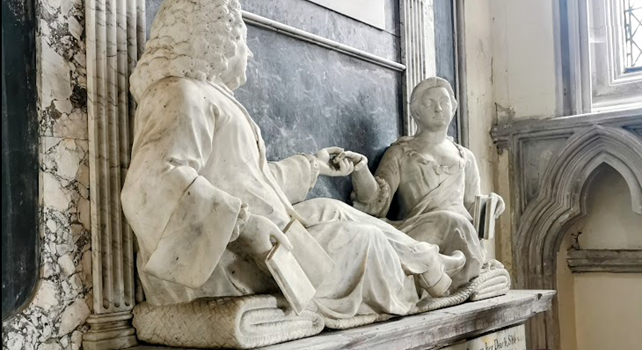by Dr N Henry
The grade one listed church in Bottisham, Holy Trinity, houses many treasures but is noticeably one of the rare churches to celebrate the lives of women and their contributions to society. Women are celebrated in all the corners of this church, on the stained windows and on the multiple plaques and funeral monuments that adorn the building. Above the vault, there is a very striking funeral monument that houses the remains of Elizabeth Jenyns, second wife of Roger Jenyns, former owner of Bottisham Hall.

The monument presents the couple seated on rolled mats, looking at each other with their arms stretched out so that their fingers meet in a romantic gesture that symbolises an enduring love and affection. More striking is their attire. As members of the wealthy Cambridgeshire gentry, they could have been represented in rich outfits, perhaps wearing layers of luxurious silk fabrics and other ornaments. Instead, the curves of their bodies are barely covered by thin tunics that reveal the contours of their upper torsos, especially that of Elizabeth. Hugh Rogers, author of a booklet on the history of the church, writes that, at the time, “the monument was thought to be “obscene” (p. 20). To the modern eye, this is a monument that celebrates love in its entirety, including perhaps its sexual element with the revealing of the flesh and the touching of hands. Of course, in its Christian dimension, this monument might have also been designed to express the idea that, in death, nothing material remains; one is denuded of wealth and luxury. Whatever the intension, such a monument was certainly unusual at the time and would have offended the eyes of puritans.

The inscription on the vault reads as follows:
In this vault lies the body of Dame Elizabeth Jenyns, wife to Sir Roger Jenny’s, who died May 1, 1728, aet. 62. She was a lady of great virtue and piety and through the whole course of her life of an unblemished reputation: a constant attender of public as well as strict observer of stated hours of her private devotion. Her piety, as well as her uncommon tenderness and compassion of nature engaged her to daily acts of charity as well in her life as at her death. She was of a mild temper, a graceful and winning presence, an easy and engaging conversation, though her own infirmity often interrupted the natural cheerfulness of her disposition. She was an affectionate Christian. At her death, Sir Roger Jenyns by her desire, settled the schooling of 20 poor children: and at his addition, the clothing of them and school to teach them and others in for ever.
Such a long and detailed description of a woman’s contribution to society was very unusual in the early 18th century and is to be cherished. Women often fell into oblivion whilst men were honoured with plaques and monuments in churches. The monument clearly states that the charitable work of Roger Jenyns was entirely driven by his love for his wife. He died twelve years later, at the age of 77. However he is still very much present in the village, not only through the legacy of his charitable contributions but also perhaps in person as the patron of the Bell, the village pub. Many have had encounters with Roger the ghost in this establishment, where customers have also seen him and the chef in the kitchen has been in communication with the ghost. Could this really be Roger Jenyns, Elizabeth’s adoring husband? Perhaps one will have to have a pint at the pub to find out!
